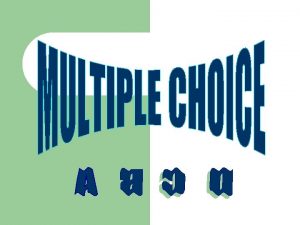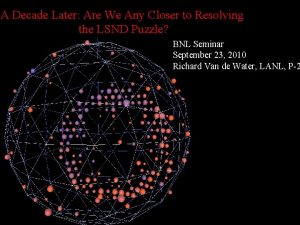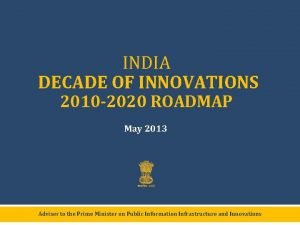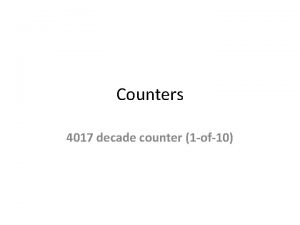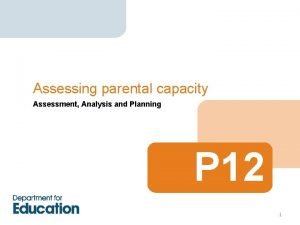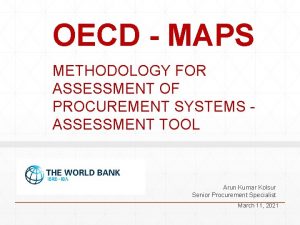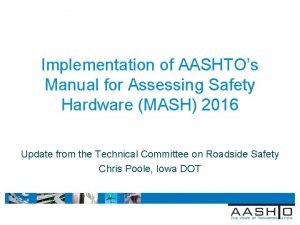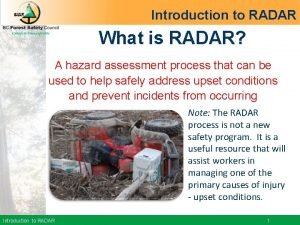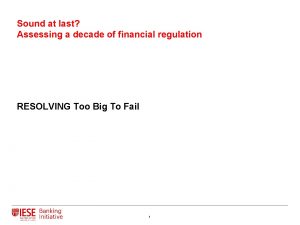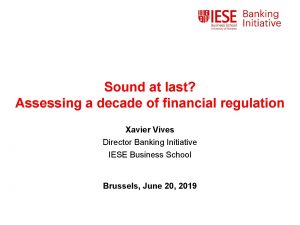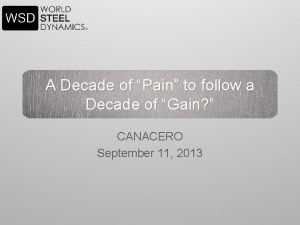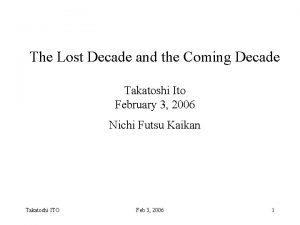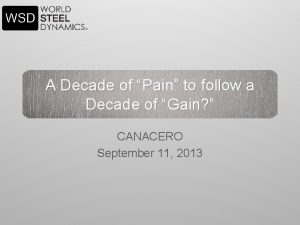Sound at last Assessing a decade of financial





















- Slides: 21

Sound at last? Assessing a decade of financial regulation RESOLVING Too Big To Fail 1

Bailout: The option that was just too easy The alternative was a disorderly Bail-in “haircuts send a destabilizing signal that more haircuts are coming, encouraging runs on financial firms. ” [Tim Geithner in Stress Test] “Unfortunately, the only way for crisis responders to stop a financial panic is to remove the incentives for panic, which means preventing messy collapses of systemic firms, assuring creditors of financial institutions that their loans will be repaid…” [Tim Geithner in Stress Test] 2

Cross-border Insolvency Barclays and Lehman “I said that we would not endorse it because basically what you’re asking me to do is to transfer the burden of a bust American bank on to the British taxpayer and there’s no way we can do that. ” Alisdair Darling (UK Chancellor of the Exchequer) Dexia, Fortis, Anglo-Irish 3

Qualified Financial Contracts Carve-out Derivatives and swaps counterparties are exempt from the automatic stay rule that applies to debt contracts in bankruptcy Derivative and swaps counterparties could unwind their positions immediately upon the bankruptcy filing Broker-dealers had large derivatives and swaps books They would have been drained of cash as a result of the unwinding of QFC positions 4

Systemically Important Bank (SIB) Resolution : Organizational Complexity 5

How has the resolution problem been addressed? NEW IDEA: Keep operating affiliates untouched and only resolve the Bank Holding Company That’s what is referred to as Single point of Entry (SPOE) 6

SIB Resolution: Single Point of Entry 7

SIB Resolution: Single or Multiple Points of Entry 8

SIB Resolution and Loss absorption Total loss absorption capacity (TLAC) : Bailinable debt 9

Resolution and Liquidity Support • Bridge financing (DIP financing) • Proscribe public liquidity provision? • Conditional Public liquidity 10

Taking Stock • SIBs have never been more prepared • Will it work as intended? • Are there any gaps? 11

Taking Stock 2 • SIBs business model is fundamentally changed • SIBs are set up never to fail • Greater pressure on SIB executives, Bo. Ds & supervisors to intervene in a timely way and avoid a build-up of losses 12

Sound at last? Assessing a decade of financial regulation AN EXPANDED ROLE FOR CENTRAL BANKS 13

Central banks in the crisis 1. Monetary policy at the Zero Lower Bound (ZLB) 2. Lender of Last Resort (LOLR) support at unprecedented levels 3. A new focus on the financial stability component of Central banks’ mandate in light of systemic risk MESSAGE: Bigger role for Central Banks demanding an update in their independence status. Not less of it - But adapted to a more visible, active role - Including new missions where coordination and cooperation with other authorities and political validation may be required - Central Bank independence 2. 0 14

Paul Tucker (2018) “In todays’ democracies the only way to combine effectiveness with legitimacy is transparency around the rules of the game. . . If credible commitment and operating as an emergency institution can be reconciled in principle, getting from ‘in principle’ to ‘in practice’ requires public deliberation and debate, so that the requisite degree of comprehension and support is established”

1. The problem of the policy mix at the ZLB • We review the experience at the ZLB with an eye on the possibility that it gives us a taste of the future • Conclude that going forward there is a need to adapt central banks’ status to facilitate policy coordination at the ZLB! • Proposal: Reaching and leaving the ZLB should define a special regime where open discussions between the government and the Central Bank (in view of coordinating policies) are encouraged and institutionalized, i. e. , rethink the practice of independence at the ZLB 16

2. LOLR • Never before practiced on this scale • Surprise, awe and backlash. Negative reactions, the outcome of opacity, itself the consequence of constructive ambiguity • Need to strengthen the democratic acceptability of delegating such powers to unelected officials 1. Abandon ambiguity: clarifying the mandate and making precise the range and scope of potential interventions of the LOLR • Risk: curtailing the ability to act; e. g. , Dodd-Frank limits the scope of actions of the FED: Bernanke-Geithner-Paulson Op-ed of September 2018 • Not inevitable: The BOE as an example 17

2. LOLR 2. Pricing liquidity insurance. How? • Beware of outsized role of Central banks in credit allocation process • Beware of exacerbating the preference for collateralized credits • A valid question, further analysis needed. • Subsidy to banks: ground for regulating remunerations (as made possible by Dodd-Frank) 18

3. Updating the financial stability mandate • An expanded role for Central banks • Should financial stability become the core of central banks’ mandate? • Is this compatible with independence? • Or is a narrow price stability mandate best suited for a technocratic institution with independent status? • How to organize cooperation among authorities for financial stability? 19

3. What role for Central banks? • All under one roof? The “encompassing model” (BOE) • Clarity and accountability • Effectiveness (notably in managing trade-offs when divergences between price and financial stability objectives) • Credibility risk if failure • Legitimacy? Paul Tucker (2018) • Taking the bull by the horns! • Or a “cooperative model” where the Central Bank focuses on price stability and shares with other authorities responsibility for financial stability? • Legitimacy is less of an issue • Questions of coordination among authorities, notably for an independent Central bank • And of accountability (inaction bias) • Thus effectiveness? • In reality, the encompassing model is the exception more than the rule. Take it as a given. Challenges demand stronger institutional arrangements 20

3. In need of stronger institutional arrangements • In view of insuring the legitimacy of delegating increasingly broad powers to an independent unelected institution and • To ensure an effective cooperation among authorities • Proposal: Clarify the modus operandi of the Financial Stability Committee or equivalent body and adopt the standards of communication prevailing in the monetary domain, mutatis mutandis. 21
 Assessing a new venture's financial strength and viability
Assessing a new venture's financial strength and viability Global plan decade of action for road safety
Global plan decade of action for road safety Harvey carignan obituary
Harvey carignan obituary The sixties a decade of protest and change
The sixties a decade of protest and change What is old susy’s place?
What is old susy’s place? 1 decade later
1 decade later Biotics research uk
Biotics research uk 20s decade fashion
20s decade fashion The sixties a decade of protest and change
The sixties a decade of protest and change 4017 decade counter
4017 decade counter Record peach harvest—price lowest in a decade
Record peach harvest—price lowest in a decade What decade did radio drama achieve widespread popularity?
What decade did radio drama achieve widespread popularity? “a sound mind is in a sound body”
“a sound mind is in a sound body” Sound waves graphic organizer
Sound waves graphic organizer Assessing leadership and measuring its effects
Assessing leadership and measuring its effects Assessing grammar effectively
Assessing grammar effectively Parental capacity example
Parental capacity example Methodology for assessing procurement systems
Methodology for assessing procurement systems Amc math assessment
Amc math assessment Manual for assessing safety hardware
Manual for assessing safety hardware Assessing the internal environment of the firm
Assessing the internal environment of the firm Assessing the situation
Assessing the situation




